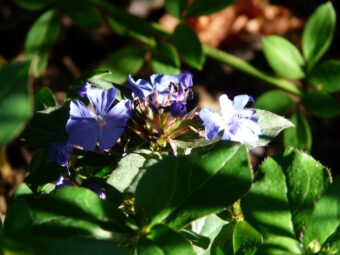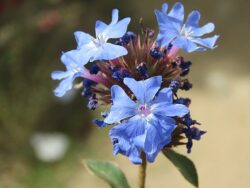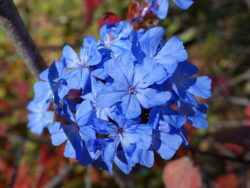In this article, we will discuss how to grow the beautiful flowering Ceratostigma in containers. Ceratostigma is a small genus of flowering shrubs that belong to the Plumbaginaceae (the Plumbago or Leadwort) family, where 8 species are known to exist.

Ceratostigma is native to warm temperate and tropical regions of Asia and Africa. The hardy plumbagos are low-growing shrubs, often only growing to 1 to 2m tall. The leaves are normally simple, 1 to 4cm long, arranged spirally with hairy margins. Some of the species are evergreen, whilst others are deciduous. There is one perennial in this genus called Ceratostigma plumbaginoides but as this is not a shrub it will not be discussed here.
The common name can be misleading, as the 3 most popular species you will find are not fully hardy, as in very cold, frosty winters, stems may be killed. Do not worry as hardy pruning in spring will ensure that new stems will appear later on in the season.
The leaves may be plain-looking but they are grown for the five-petal, pale blue, dark blue, or red-purple flowers that look like a garden phlox that appear in summer to early autumn. The flowers are borne in clusters but are killed when the first frosts appear. The flowers are followed by fruit-like seed heads containing a bristly capsule with a single seed inside.
The leaves may not look anything special but once autumn arrives the leaves take on a vivid yellow, orange, red and brown colour.
Find out how to grow this shrub in containers in this article.
GROWING CERATOSTIGMA IN CONTAINERS

First, you will need to find a large enough container that will highlight the blues of the flowers of the shrub. Make sure it is large enough to support the plant in question and it has plenty of drainage holes at the bottom to allow excess water to drain away. To the bottom of the container, add a 2cm layer of gravel to aid drainage even more. Plumbagos are not fussy about what compost or soil it is grown in, so should be easy to look after. You can fill the container with any multipurpose compost up to 5cm below the rim.
Dig a hole at the centre slightly larger than the root ball it came in the original container. Place the plant in the hole so that the top of the root ball is at the same level as the top surface of the compost. Backfill with the growing media so that no vacant areas exist, using more compost if necessary. Firm the plant in and water well.
BEST GROWING CONDITIONS
You will need to place the container in a position where it is protected from strong winds and frost pockets in full sun.
You will need to water regularly throughout the growing season until the plant is well established. It is advised that it is best to water when 5cm below the top surface of the container feels dry to the touch. Water until it just emerges from the drainage holes.
They are not particularly hungry plants but in containers, it is recommended to give an annual feeding of slow-release fertilizer to give it enough nutrients to get it through the growing season.
Pruning is required in spring to remove any dead wood caused by damage in winter. This will also keep them in shape and will encourage better flowering.
To propagate you can plant semi-ripe cuttings in a cold frame in summer for planting out the year after.
PESTS AND DISEASES
The good news is that pests do not seem to eat the leaves of the plant as they do not like them. In terms of diseases, they can suffer from powdery mildew. To avoid this, you will need to water especially in hot, dry summers and to make sure there is adequate airflow between the leaves of the plant. If you do experience powdery mildew, you may need to spray with a suitable fungicide that can treat the conditions on ornamental shrubs.
VARIETIES TO GROW

Three species are hardy enough to be grown outdoors in a UK climate.
Ceratostigma willmottianum is one of the hardiest and produces the bluest flowers if all the growing conditions are met-dry, sheltered and sunny locations. Best grown against a south-facing wall. Varieties to grow include ‘Sapphire Ring’, which grows up to 1.2m in height and ‘Forest Blue’.
Ceratostigma griffithii is more compact than C. willmottianum and rounder too. The leaves are broader, but it is less hardy. The flowers are a deeper blue and the leaves turn red and are more conspicuous.
Ceratostigma abyssinicum is a tender shrub that has sky blue flowers. It is only half-hardy and needs the protection of a home or greenhouse to survive a harsh UK winter.
CONCLUSIONS
In this article, we have discussed how to grow the vivid blue but hardy Ceratostigma in containers. They are such delightful, compact shrubs that will do well in the UK, as long as you give them shelter, sun or not too much moisture. They are easy to look after, easy to care for, and will not suffer from pests but they can suffer from powdery mildew.
A plant that will give much-needed blue to the container display.
If you have any questions or comments that you wish to make on growing Ceratostigma in containers, please do so in the comment box below.
Happy Ceratostigma growing.
